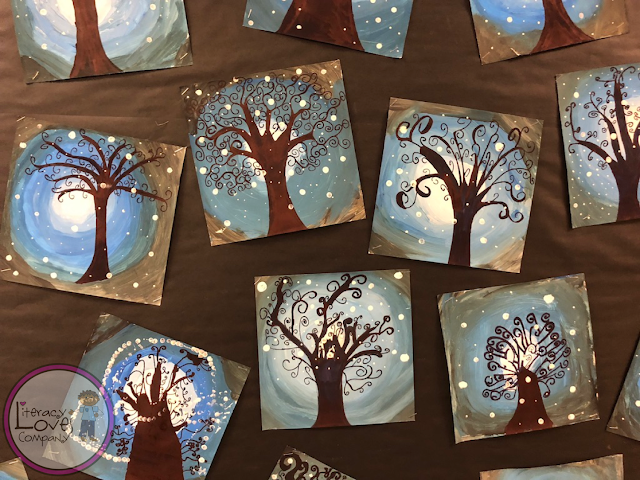Happy Sunday Afternoon! I'm sitting here in my living room looking out at the beautiful February sunshine. The funny thing is, this weekend we were forecasted to have the snowstorm to end all snowstorms... grocery stores were rampaged. Gas station lines were miles long. Teachers and students alike were prepping for snow days this week. It's now Sunday and I am looking out at bare ground and glorious sunshine. I'm not sure if I should be disappointed or relieved.
As a type of precursor to this "snowpocolypse", my students completed their snowy tree art project this week and we finally got them on display. They turned out beautifully... each one is unique and the whole display is magical!
I often get my inspiration for classroom art from the internet. While searching for a winter project, I came upon a photo of a project similar to the one you see above. As I prepped for writing this post, I tried to search it out so that I could give the original poster credit and was unable to find it.
One of the things I love to do is find an original piece of art and try to figure out a way to make it accessible to my own students. This means determining which medium to use with our limited resources and the step-by-step order for the project since we have limited time. This project takes at least two sessions with drying time in between.
For this project we used these materials:
white card stock cut into 8 1/2 by 8 1/2 squares
white, blue, and black tempera or acrylic paint
sharpie markers
larger black permanent markers
Prep:
I cut the paper into the squares.
I put plates and paint brushes on each group table. On the plates I put a dollop of white, blue, and black paint.
Step One:
Students paint the background by painting a white circular shape in the middle of their paper. As students work out from the middle of the page, they mix blue into the edge of their white paint creating a light blue. As they work out toward the edge of the paper, they continue to add blue until they are using pure blue. At that point they start to add black to their blue to darken it and continue to work out until they work their way off of the page. Many of my students went back in with white, after cleaning their brush, to smoothed out and widen the middle circle. We stopped at this point, cleaned up, and let the paintings dry.
Step Two:
Once the painting dry (later that day or days later) hand out the paintings, Sharpie markers, and bold tip permanent markers. I demonstrated for my students, under the document camera, how to draw the curvy branches and fill in the trunk.
Some students positioned their trees in the center of the page and others off to the side. Both are beautiful!
Step Three:
The final step is to put "snowflakes" on the page. provide one dollop of white paint for each group of about 4 students. I happen to have corndog sticks that we used to make the tiny dots (pointed end) and the large dots (blunt end). You could also use small dowels, toothpicks, the handle end of paintbrushes, etc. The goal is to make sure the dots are random around the page.
The results were magical! Every tree turned out just as unique as the artist who painted it.
I hope that this post has inspired you to create some magical winter trees with your students. If you do, please share your pictures on Facebook and/or Instagram and tag LiteracyLovesCompany. I'd love to see your beautiful pieces of art.
Thank you for visiting!
















